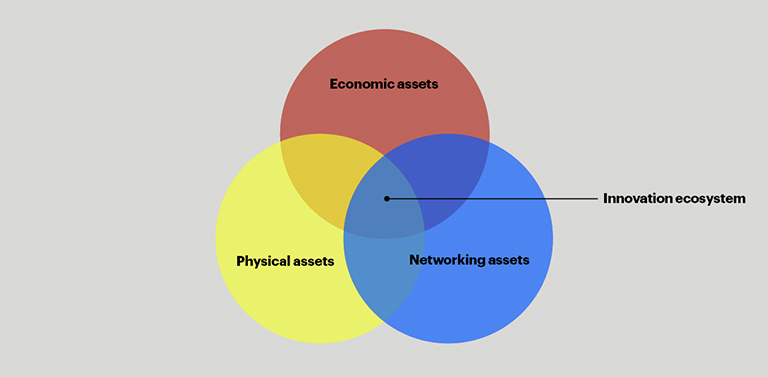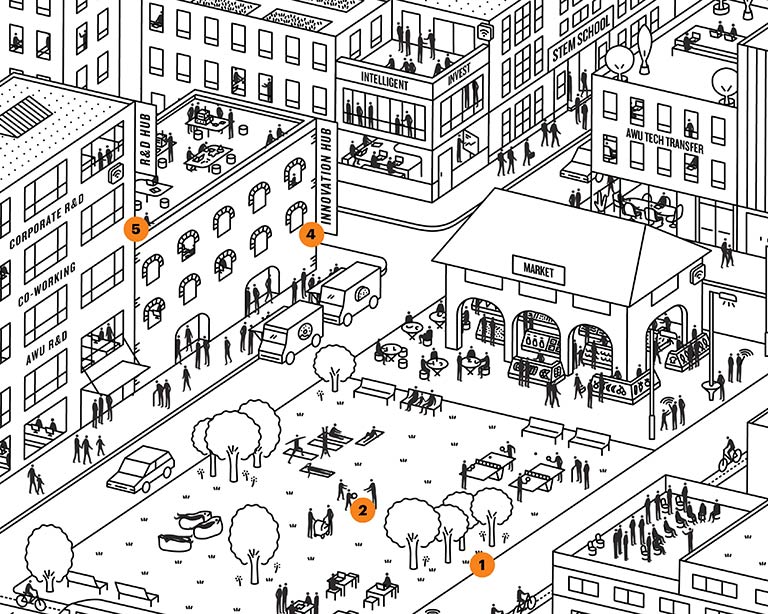More likely than not, your university or industry—despite ongoing efforts to strengthen collaborations with nearby organizations through new instruments, intermediaries and incentives—is failing to reach its full potential. A painful thought considering all the time and resources devoted to strengthening these relationships as a means to increase your innovation potential, and one that potentially has wide-ranging implications for the higher education sector going forward to 2040.
After traversing the globe, visiting countless university-led innovation ecosystems, a widespread finding is a failure to value “place,” or the physical landscape in facilitating dense social networks, both intentionally and serendipitously. For the past five years, the Brookings Institution has been researching the rise of new geographies of innovation and the radical re-making of existing ones—all of which are putting place at the heart of their innovation ecosystem. Documented in the 2014 Brookings paper, The Rise of Innovation Districts1, this trend continues to be confirmed through our work on-the-ground in places as diverse as St Louis, Stockholm and Melbourne. It is also why we partnered with Project for Public Spaces to advance this work.
The emergence of innovation districts comes, in part, from the physical assets and attributes they offer, sending new signals about what matters in today’s economy. The density of, and proximity between, university and industry actors connected by short, walkable blocks is helping local leaders facilitate new social networks. R&D-laden universities and industries are likely to rely on density and proximity because tacit knowledge is exchanged through close connections and is difficult to translate and transfer over long distances2.
Just as important as the increased value of networks is the changing preferences of workers and firms. Increasingly, innovation districts offer a mix of activities— housing, amenities and diverse work environments tied together by an actively used public realm, which appeal to talent and companies alike3.
Taken together, the density of firms, diversity of amenities, and liveliness of places are proving to be powerful enough to “un-anchor anchors”—that is, to entice seemingly unmovable institutions and corporate research facilities to relocate into districts4.
All of these observations have led to the conclusion that innovation districts are effectively re-making themselves to create a “place-based innovation ecosystem,” where place assets, along with economic and networking assets, contribute to the cultivation of idea generation, joint problem-solving, and more.
 But don’t view these emerging innovation districts as best practice just yet. Although they have the “physical bones” necessary to facilitate networks and lure talent, more work is still necessary for place to become the connective tissue between people, firms, and a broader network of actors.
But don’t view these emerging innovation districts as best practice just yet. Although they have the “physical bones” necessary to facilitate networks and lure talent, more work is still necessary for place to become the connective tissue between people, firms, and a broader network of actors.
If innovation districts have more work ahead, imagine what this means for other university and economic clusters that have never considered the strategic value of place.
A Place-Based Approach to Innovation: The Fundamentals
A place-based approach to innovation demands that universities and industries think differently about the physical landscape. Genuinely great places are about more than aesthetics; they create a community that values active, iterative learning, risk sharing, and collaborating to compete. To achieve this, local actors must think critically about their geography at various scales.
At the broader geographic or district scale, the goal is to have a critical mass of university, industry and other economic actors easily connected and accessible to each other and to the broader metropolitan area.
Given that university-centered innovation geographies can range from roughly 120 to 400 hectares5, more in-depth analysis is needed to understand which physical characteristics are advancing or hindering their progress, such as physical impediments that limit access from the broader region and/or city (e.g., highways, railroad tracks, bodies of water, and large parks), or how zoning and land use conditions may limit firm and talent connectivity.
At the nodal scale, the ambition is to create the level of density and mixing needed to create a highly networked and “buzzing” innovation community. A common mistake is to spread physical investments evenly across a vast innovation geography. Activity nodes can take shape in many configurations: Sometimes along a key corridor; sometimes centered on a public space; and sometimes surrounding a magnetic innovation center or hub6.
The rendering below illustrates how working at a smaller scale allows local actors, involving the community of workers and residents, to:
- Strengthen connections between people and firms by creating a short, walkable street grid.
- Design and manage public spaces to spur interaction, learning and networking.
- Reconceive the ground floor of buildings activated with cafés, retail and gathering places.
- Locate university, company, and start-up spaces in close proximity, including affordable workspaces.
- Concentrate on programming—activities that help incubate new enterprises, accelerate learning, and strengthen networks between people and firms.

At the building or human scale, the idea is to create places, including small spaces, that facilitate social networking as much as independent work. Every building, including the office and the ground floor spaces they provide, is an opportunity to be exploited. While architects may create aesthetically beautiful places inside buildings, they often fail to grasp the organizational culture, the importance of collaboration, and how this changes over time. Brookings research identified a new wave of innovation spaces that are putting various techniques for network building and collaboration into action7, such as the creation of more flexible, moveable spaces and open floor plans where university and industry workers can easily mix8.
Early insights from first movers — the universities valuing place as a means to compete — indicate that universities and their industry partners will play a far more transformative role in their cities and regions. They will elevate the value of place in shaping and strengthening local economies while creating healthy, vital places in the process. We will be watching.
1 Katz, B., & Wagner, J. (2014). The rise of innovation districts: A new geography of innovation in America. Washington: Brookings Institution. Retrieved from www.brookings.edu/essay/rise-of-innovation-districts/
2 Scott, A. (2016). How Firms Learn: Industry specific strategies for urban economies. Washington: Brookings Institution.
3 Urban Land Institute. (2013). America in 2013: A ULI Survey of Views on Housing, Transportation, and Community; Nelson, A. C. (2013). Reshaping metropolitan America: Development trends and opportunities to 2030. Island Press.
4 Scott, A., & Katz, B. (2016). Why Today’s Corporate Research Centers Need to Be in Cities. Harvard Business Review. Retrieved from https://hbr.org/2016/03/why-todays-corporate-research-centers-need-to-be-in-cities
5 Note that these geographies of innovation—be it self-proclaimed innovation districts or university-centered innovation ecosystems— do not have rigid geographies. Instead, general boundaries change over time in response to market forces.
6 Wagner, J., Davies, S., Sorring, N., & Vey, J. (2017). Advancing a New Wave of Urban Competitiveness: The Role of Mayors in the Rise of Innovation Districts. Retrieved from https://www.brookings.edu/research/advancing-a-new-wave-of-urban-competitiveness/
7 Wagner, J., & Watch, D. (2017) Innovation Spaces: The New Design of Work. Washington: Brookings Institution. Retrieved from https://www. brookings.edu/research/innovation-spaces-the-new-design-of-work/
8 Ibid.
